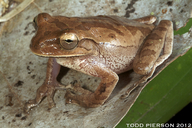|
Description
Smilisca puma is a moderate-sized golden-tan tree frog (32 to 38 mm adult male SVL, 40 to 46 mm adult female SVL) that has a white labial stripe, a white forearm stripe, a white tarsal stripe along the outer margin of the tibial segment of the leg, and lacks finger webbing. The dorsal pattern consists of paired elongate dark brown to green blotches which branch out across the midline at one or several points. A broad, irregular dark brown to dark green stripe extends posteriorly from each eye and eventually becomes either an H-shaped mark or breaks into spots. Anterior flank has fine dark lines. Inguinal region is white with dark mottling. The posterior thigh surfaces are dark brown. The venter is creamy white. The iris is deep bronze (Savage 2002).
The dorsal surface is smooth. The head is slightly longer than broad with a rounded snout in profile, small eyes, and a distinct tympanum which has a diameter one-half to seven-tenths of the eye diameter. Fingers are short and stout with moderately expanded discs and lack webbing. Toes are weakly webbed. Adult males have paired vocal slits and fully distensible paired grayish brown external subgular vocal sacs. Breeding males also have a light brown nuptial pad on the base of each thumb (Savage 2002).
Larvae are moderately sized, up to 24 mm at stage 34. Body shape is ovoid, mouth is anteroventral, nostrils and eyes are dorsolateral, the tail is short, and the tail tip is rounded. Spiracle is lateral and sinistral, while the vent tube is dextral. Oral disc is small and entire with serrated beaks, 2/3 denticle rows (gap in A2). Single row of papillae on upper labium, two on lower labium, wide gap above mouth, and many additional papillae at angle of jaws. Larval dorsum is olive brown with greenish tan flecks; tail fins are pale brown with greenish gold flecks. Dark markings on tail musculature and anterior fin bases with dark flecks on the posterior fin bases. Iris is bronze (Savage 2002). Distribution and Habitat
Country distribution from AmphibiaWeb's database: Costa Rica, Nicaragua
Smilisca puma is found in humid Atlantic lowlands of Costa Rica and adjacent Nicaragua (15-520 m asl). It occurs in relatively undisturbed Atlantic Lowland Moist and Wet Forests (Savage 2002).Life History, Abundance, Activity, and Special Behaviors
Smilisca puma are rarely seen nocturnal treefrogs (Savage 2002). They are usually only found in close proximity to their breeding sites (generally small, shallow temporary pools or ponds within the forest but sometimes more open areas) (Savage 2002; Duellman 1967). Males call in small choruses (2-4 males) during the rainy season (February through September) from shallow water and low bushes, while hidden in the vegetation (Savage 2002). Each frog alternates calls with nearby neighbors (Savage 2002). The call sounds like a low squawk, lasting 60-350 msec, and is usually followed by one or more secondary rattling notes lasting 100-470 msec, with dominant frequencies of about 0.74 and 1.897 kHz (Duellman 1970). Although calling takes place throughout the rainy season, breeding itself is restricted to periods of heavy rain from June through August (Savage 2002).
Tadpoles are benthic. Newly metamorphosed froglets are 12.5 mm SVL (Savage 2002). Trends and Threats
Smilisca puma is classified as Least Concern due to its wide distribution and presumed large population. However, habitat loss and degradation due to small and large-scale agriculture and logging represent major threats. The forests of south-eastern Nicaragua have been less altered than those in adjacent Costa Rica. This species does occur in a number of protected areas and can tolerate disturbed habitat (Bolaños et al. 2004). Possible reasons for amphibian decline General habitat alteration and loss
Habitat modification from deforestation, or logging related activities
Intensified agriculture or grazing
Comments
A Spanish-language species account can be found at the website of Instituto Nacional de Biodiversidad (INBio).
References
Bolaños, F., Chaves, G., and Kubicki, B. 2004. Smilisca puma. In: IUCN 2009. IUCN Red List of Threatened Species. Version 2009.1. www.iucnredlist.org. Downloaded on 22 September 2009.
Duellman, W. E. (1967). ''Courtship isolating mechanisms in Costa Rican hylid frogs.'' Herpetologica, 23(3), 169-183.
Duellman, W.E. (1970). The Hylid Frogs of Middle America. Monograph of the Museum of Natural History, University of Kansas.
Savage, J. M. (2002). The Amphibians and Reptiles of Costa Rica:a herpetofauna between two continents, between two seas. University of Chicago Press, Chicago, Illinois, USA and London.
Originally submitted by: David Chen (first posted 2008-05-11)
Edited by: Kellie Whittaker (2009-11-02)Species Account Citation: AmphibiaWeb 2009 Smilisca puma: Cross-banded Treefrog <https://amphibiaweb.org/species/1167> University of California, Berkeley, CA, USA. Accessed May 6, 2025.
Feedback or comments about this page.
Citation: AmphibiaWeb. 2025. <https://amphibiaweb.org> University of California, Berkeley, CA, USA. Accessed 6 May 2025.
AmphibiaWeb's policy on data use.
| 